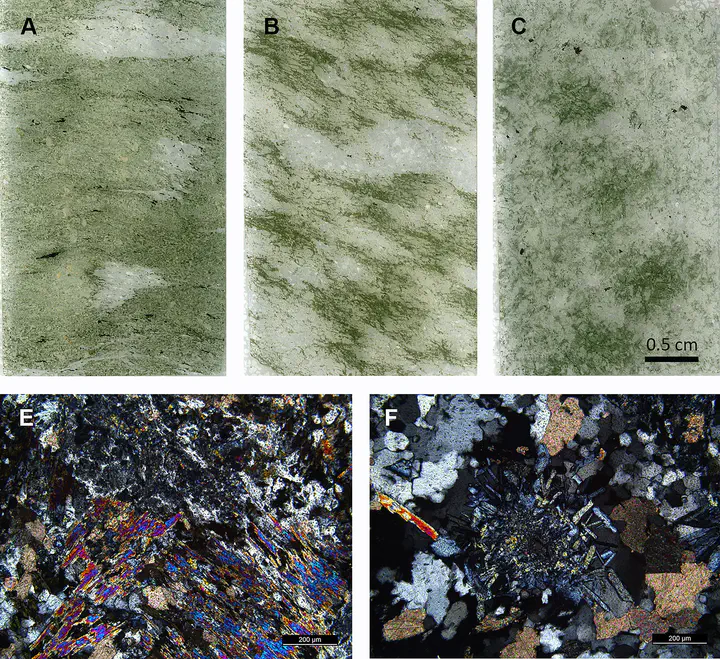High-CO$\\_2$, acidic and oxygen-starved weathering at the Fennoscandian Shield at the Archean-Proterozoic transition
 The appearance and texture of the paleoweathering crust: images A, B and C are scans of whole thin sections in ordinary incident light, and the scale bar at the right applies to all three images. The rock is intensely weathered at 1.8 m below the surface (A), with less altered basalt at 5.2 m depth (B), and the least-altered parent rock at 11.5 m depth (C). Amphibole in the basaltic parent rock is altered as evidenced by dissolved edges of the crystals (E, image taken in crossed polars), whereas deeper at 11 m depth, actinolite fibrous overgrowth is evident (F, image taken in crossed polars).
The appearance and texture of the paleoweathering crust: images A, B and C are scans of whole thin sections in ordinary incident light, and the scale bar at the right applies to all three images. The rock is intensely weathered at 1.8 m below the surface (A), with less altered basalt at 5.2 m depth (B), and the least-altered parent rock at 11.5 m depth (C). Amphibole in the basaltic parent rock is altered as evidenced by dissolved edges of the crystals (E, image taken in crossed polars), whereas deeper at 11 m depth, actinolite fibrous overgrowth is evident (F, image taken in crossed polars).
Abstract
Chemical weathering of continental crust plays an important role in Earth‘s surface evolution and also controls the nutrient flow to the ocean. Major changes in the development of Earth’s geochemical system were taking place at a critical time coinciding with the Archean-Proterozoic transition when Earth’s atmosphere became oxygenated, thus triggering a whole new set of chemical weathering reactions. A paleoweathering crust on basalts of the Kuksha Volcanic Formation in the Paleoproterozoic Imandra-Varzuga Greenstone Belt, northwestern Russia developed between 2.5 and 2.44 Ga, just before the Great Oxidation Event and can potentially shed light on the paleoatmosphere composition and weathering modes of this time. The 3 m-thick Kuksha paleoweathering profile is characterized by Al-phyllosilicate clay minerals that are typical products of strong chemical weathering of igneous rocks. The mineralogy of the uppermost part of Kuksha weathering crust confirms formation under high CO2 partial pressures, consistent with previous estimates of pCO2 exceeding 0.1 atm during that time interval. That is in agreement with the geochemical and mineralogical proxies thereby also suggesting an intense acidic weathering under low-oxygen conditions.